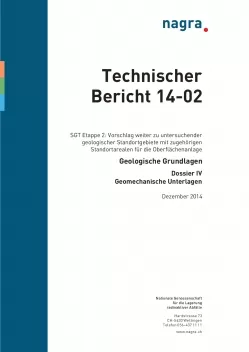
Technischer Bericht NTB 14-02/IV
SGT Etappe 2: Vorschlag weiter zu untersuchender geologischer Standortgebiete mit zugehörigen Standortarealen für die OberflächenanlageGeologische GrundlagenDossier IV:Geomechanische Unterlagen
Dossier IV: Geomechanical data
Dossier IV on geomechanical data provides an overview of the available empirical and experimental findings on the deformation behaviour of the proposed host rocks and the geomechanical conditions expected in the potential geological siting regions. The geomechanical database is used to derive general material laws that form a basis for the analytical modelling of construction and safety aspects as part of the safety-based comparison of the siting regions. The geomechanical information comprises the following:
- Description of the stress regime on a regional and local scale. For this purpose, the existing database was supplemented with field measurements of the palaeo-stress field, complementary analyses of borehole breakouts and hydrofrac measurements in recent boreholes. Updated stress maps were also prepared for Northern Switzerland and the surrounding areas. Numerical models were used to investigate the local stress conditions in selected situations for a wide range of tectonic boundary conditions. Of particular importance for geomechanical applications were the estimates of the magnitudes of the principal stress components expected at repository depth, including associated uncertainties.
- Characterisation of the geomechanical properties of the host rocks (stiffness, strength, consolidation and swelling behaviour) Laboratory investigations were recently carried out on core samples from the Opalinus Clay, which is considered to be challenging in terms of construction due to its low tensile strength and its moderate swelling capacity. On the other hand, it represents an excellent transport barrier for radionuclides due to its self-sealing capacity. The extended geomechanical database was used to derive constitutive laws and associated parameter sets for the Opalinus Clay; this ensures the transferability of the findings on the deformation behaviour of the rock to the different geological situations in the proposed siting regions. The geomechanical properties were compiled in tabular form for the other host rocks.
- Description of the structural geological conditions in the siting regions as the basis for site-specific classification of the host rock in terms of prevailing tectonic overprinting (rock models) Structural analyses of the outcrops mapped on a regional scale in Stage 2 and imaging of structures on core samples from deep boreholes, combined with structural geological interpretation of the new 2D seismic measurements, provided the database for a site-specific inventory of discrete structural features. A comparison of the structural analyses with the available geomechanical data was used to derive rock models that allow the structural inventory of the Opalinus Clay arising from tectonic overprinting to be classified in terms of loss of strength compared to the intact rock. The anisotropic softening of the rock along bedding planes was explicitly taken into account.
The data compiled on the deformation behaviour of the host rocks in the siting regions provide the hydromechanical conceptual models and reference data for the geoscientific analyses used for evaluating the geotechnical conditions of a deep geological repository, for the assessment of repository-induced effects and, last but not least, for the evaluation of hydromechanical unloading effects in the context of long-term geological evolution. This Dossier investigates the phenomenology and conceptualisation of unloading effects in the repository surroundings. Simple analytical tools are used to investigate the effect of overburden on the geotechnical conditions during construction of a geological repository. The results of hydromechanical analyses of self-sealing of the excavation damaged zone are also presented; these are used to perform a quantitative evaluation of the hydraulic significance of the excavation damaged zone after closure of the repository for different geological situations. Finally, the change in the hydraulic barrier function of the Opalinus Clay as a result of rock decompaction is estimated within the context of long-term geological evolution (erosion, neotectonics) using semi-empirical evidence.
